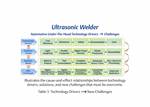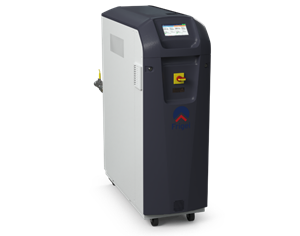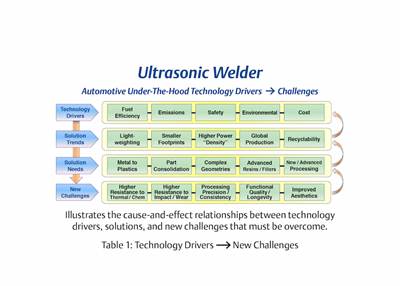What Is the Right Plastics Joining Process for You: Part 2—Available Technologies
The four primary joining technologies—vibration, clean vibration, infrared, hot-gas/convection—offer different benefits and challenges for different applications.
Vibration welding uses heat energy generated when one part is held stationary while the other part is moved in a linear, back-and-forth motion. The heat generated initiates a controllable meltdown at the interface of the parts. Vibration welding requires that the part interface accommodate the relative motion inherent in the process. Typical motion is 1 mm in each direction for 240 Hz welding and 2 mm in each direction for 100 Hz welding.
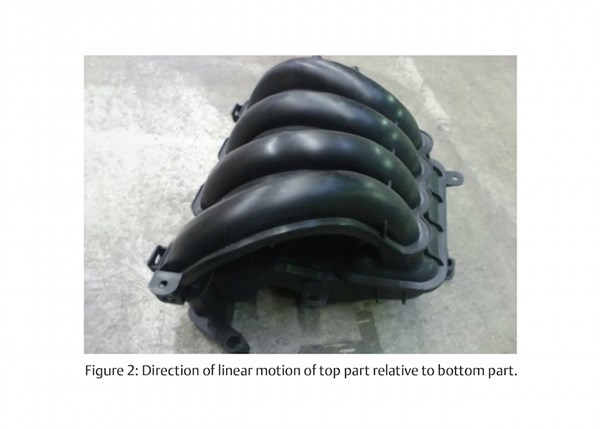
Figure 2 shows an air intake manifold made from PA6 GF30. While the geometry is complex, the parts are designed so that there is a part-to-part orientation that will accommodate the linear motion required by the process. Jagged weld flash and particulates are typical byproducts of vibration welding. “Flash traps” are designed into the parts—Figure3—to contain the flash produced during the weld. However, in some designs, part geometry does not always allow for this method of flash containment.

Infrared welding uses energy that is radiated by gray body emitters mounted on a movable platen. It is a non-contact process in which the parts to be joined are brought close to the emitter platen (approximately 1 mm) as energy is absorbed at the weld interface. The parts are then pressed together, achieving a bond that is controlled during meltdown.

Infrared emitters are typically either glass bulb or metal foil (Fig. 4). To optimize energy absorption in the weld area, the emitters should have an output energy profile that accommodates the absorption efficiency profiles of the many plastics used (Fig. 5). Medium wave emitters have this characteristic and are best for plastics joining.
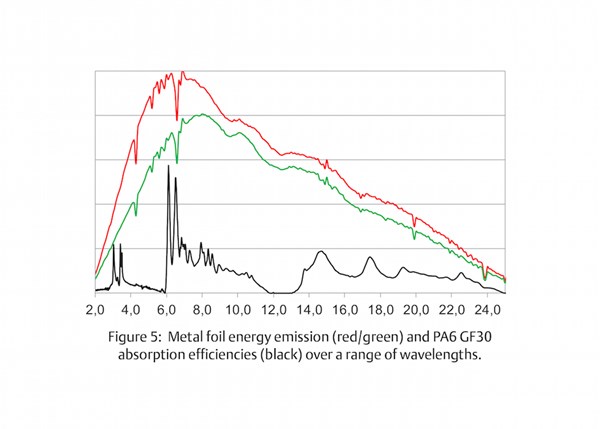
Clean vibration technology (CVT) combines IR preheating (Fig. 6) followed by a vibration weld cycle. The preheat step enables the combined process to bypass the dry friction phase in traditional vibration welding, which generates the common particulate and jagged flash (Fig. 7). In CVT welding, the flash produced is clean and compact, similar to that of IR welding. Figure 8 shows a fluid reservoir requiring a hermetic seal, high strength, and a clean weld joint. Geometry constraints did not allow for the option of flash traps so weld aesthetics were also important.
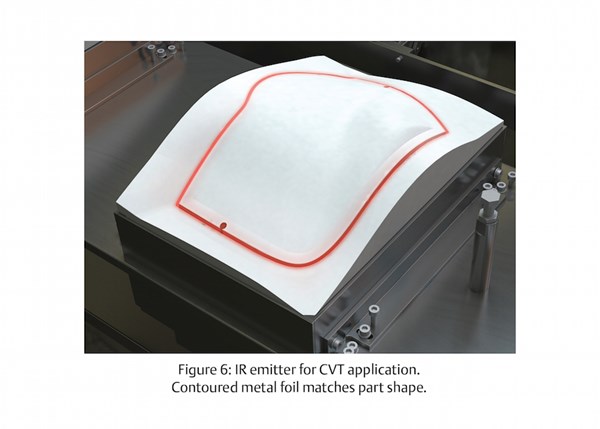


Laser welding uses energy typically generated by one or more 980 nm laser sources to heat the parts during the weld cycle. Several techniques exist that deliver the laser energy from its source to the plastic parts, including simultaneous, quasi-simultaneous and trace welding. All techniques deploy the concept of through transmission welding, in which the parts are clamped together as the laser energy is transmitted through one part and absorbed by the second part at the mating interface. The absorbed heat is conducted across the part interface, thus achieving a controlled melt in both parts.
Laser welding accommodates highly complex parts, achieves high-strength welds, and, in the case of simultaneous laser welding, has very fast cycle times. The resulting weld joint has very little flash and virtually zero particulate. No relative motion or high-temperature heat sources are required during the weld process, so parts with delicate internals are often candidates for this technology. Laser welding requires parts with good dimensional tolerances and also requires one part to have a higher transmission/absorption ratio (at 980 nm) relative to the other. This is usually accomplished by using selective colorants in the parts.
Figure 9 shows a laser welded electronic control module that has delicate internals and a very thin wall, creating very little room for a weld joint.

Hot gas (convection) welding uses the energy in electrically heated air that is directed out of an array of nozzles mounted on a movable platen. It is a non-contact process in which the parts to be joined are brought close to the air nozzle platen (<1 mm) for a preset amount of time while the heated air is directed toward the weld joint area. The parts are then pressed together, thereby achieving a controllable welded joint. Instead of using heated air, exhaust gas from natural gas or methane combustion may be used as the heating medium. This reduces the amount of oxygen in the hot gas, which reduces heating time. The hot gas welding process has advantages similar to IR welding, but it requires a consumable gas if the natural gas or methane approach is used. Very tight dimensional tolerances of the parts are required in this process.
Other technologies are, of course, available for plastics joining that remain viable for a number of under-the-hood applications. These include hot plate welding, spin welding, and ultrasonic welding. While these processes are not described in-depth here, they are also an important part of an overall technology evaluation for any application.
This is part 2, read part one of Choosing the Right Plastics Joining Process.
About the author: Craig Birrittella holds the position at Emerson as Automotive Segment Manager, Americas, for Branson Ultrasonics, Danbury, Conn. Graduating from State University of New York at Buffalo with a mechanical engineering degree, Craig holds a patent related to using a lens to adapt laser intensity for uniform welding. Emerson is a global manufacturer of Branson Ultrasonics material joining and precision processing equipment. He can be contacted at Craig.Birrittella@Emerson.com.
Related Content
All-Motor Driven Pad Printing Machine
Deco Technology now selling the new ML-500E linear & servo motor driven from microPrint of Switzerland
Read MoreNext Generation of Ultrasonic Bonding Technology
Dukane’s Infinity family boasts accurate control maintained through all phases of the welding process.
Read MorePress-Side TCUs and Full-Plant Adiabatic Coolers
NPE2024: Frigel North America will launch RSY Syncro and RS/MD series, as well as new innovations in at-the-press and whole plant cooling.
Read MoreA Guide to Ultrasonic Welding Controls
Ultrasonic welding today is a sophisticated process that offers numerous features for precise control. Choosing from among all these options can be daunting; but this guide will help you make sense of your control features so you can approach your next welding project with the confidence of getting good results.
Read MoreRead Next
What Is the Right Plastics Joining Process for You? Part 1
Changing demands, advancing technology and a process-neutral approach to plastics joining for under-the-hood automotive parts.
Read MoreAdvanced Recycling: Beyond Pyrolysis
Consumer-product brand owners increasingly see advanced chemical recycling as a necessary complement to mechanical recycling if they are to meet ambitious goals for a circular economy in the next decade. Dozens of technology providers are developing new technologies to overcome the limitations of existing pyrolysis methods and to commercialize various alternative approaches to chemical recycling of plastics.
Read MoreWhy (and What) You Need to Dry
Other than polyolefins, almost every other polymer exhibits some level of polarity and therefore can absorb a certain amount of moisture from the atmosphere. Here’s a look at some of these materials, and what needs to be done to dry them.
Read More
